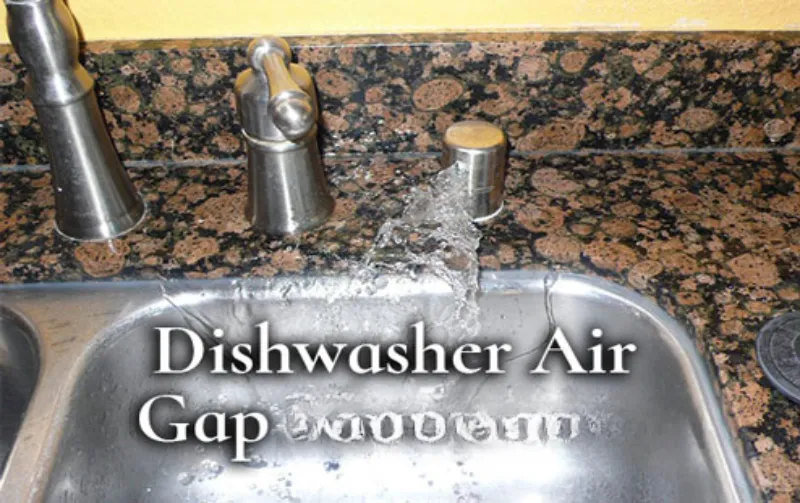Yes, you can install a dishwasher without an air gap, but local building codes may require one. Many areas allow alternatives like high-loop installation or air gap substitutes.
Installing a dishwasher is a common home improvement task that often raises questions about the need for an air gap.
An air gap prevents contaminated water from siphoning back into the dishwasher, which can happen if a sink backs up and there’s a direct connection between the dishwasher and the sewer line.
While not always mandatory, air gaps are a failsafe method to protect your dishwasher and home from wastewater contamination.
Homeowners may consider alternative methods, such as creating a high loop in the dishwasher drain hose, which can be secured to the underside of the countertop to prevent backflow.
While this method is accepted in some jurisdictions, it’s crucial to check with local plumbing codes to ensure compliance and maintain the safety of your home’s water supply.

Understanding The Air Gap Concept
An air gap serves as a critical safeguard in a dishwasher installation, preventing contaminated water from flowing back into the clean water supply.
It is a small device installed between your dishwasher’s discharge hose and the sink drain or garbage disposal.
The main purpose of the air gap is to prevent the siphoning of dirty water into the dishwasher, which could potentially introduce harmful bacteria and compromise the cleanliness of your dishes.
It maintains a clear physical separation between the end of the discharge hose and any potential contaminants.
Dishwasher air gaps are considered essential components due to their role in maintaining sanitation and safety.
Their implementation varies according to local plumbing codes, which can mandate their use based on regional regulations and building standards.
Homeowners should familiarize themselves with these requirements to ensure compliance and functional integrity of their dishwashing system.
Alternatives To Using An Air Gap
Installing a dishwasher without an air gap can seem daunting, but several alternatives ensure proper drainage and prevent contamination.
One common option is the high loop method, which involves securing the dishwasher drain hose as high as possible under the kitchen sink.
This creates a natural high point in the hose, preventing dirty sink water from backflowing into the dishwasher.
The loop with an air gap follows a similar approach but includes a small air gap device at the top of the loop.
This device, while not as robust as a typical air gap installation, still offers some protection against wastewater backflow.
Last, the standpipe method is another viable option, involving a vertical pipe to which the dishwasher hose is connected.
This pipe is typically higher than the overflow level of the sink, providing a physical barrier against back-siphoning while allowing air to break the siphoning effect, akin to a traditional air gap.
Tips For Successful Installation
Installing a dishwasher without an air gap is possible, although not always recommended due to local building codes and manufacturer’s instructions.
Prior to starting the installation, ensure you have the correct tools and materials, such as a screwdriver, adjustable wrench, dishwasher connector kit, and Teflon tape.
| Step | Action |
|---|---|
| 1 | Shut off the water supply and disconnect power to the area. |
| 2 | Prepare the dishwasher space and level the unit. |
| 3 | Connect the water supply line to the dishwasher’s inlet. |
| 4 | Attach the drain line to the waste disposal or sink drain. |
| 5 | Test for leaks and fix any issues immediately. |
Encountering problems during installation is not uncommon.
Lack of water to the dishwasher can indicate an issue with the water supply line, whereas a failure to drain may suggest a kink in the drain hose.
Always refer to the manufacturer’s manual for specific troubleshooting tips tailored to your model.
Frequently Asked Questions For Can You Install A Dishwasher Without An Air Gap
Is An Air Gap Necessary For Dishwashers?
Not all local building codes require an air gap for dishwashers, though they can prevent dirty water from siphoning back into clean water.
What Can Replace A Dishwasher Air Gap?
High loop installation or check valves can serve as alternatives to traditional dishwasher air gaps, but always check local regulations.
How Does A High Loop Installation Work?
A high loop installation elevates the dishwasher drain hose above the sink’s overflow level, preventing backflow of water without an air gap.
Does Installing Without An Air Gap Void Warranties?
Some manufacturers may void the warranty if a dishwasher is installed without an air gap; it’s essential to review your dishwasher’s warranty terms.
Conclusion
Wrapping up, and understanding local plumbing codes is crucial before bypassing an air gap in your dishwasher installation.
Remember, the primary goal is to keep your home’s water supply safe.
For personalized advice, always consult a plumbing expert. Safeguard your kitchen from potential contamination with well-informed decisions.
